plugs
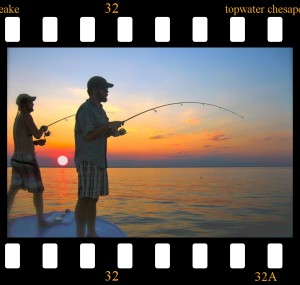 Lights! Action! Intensity! Get those video camera’s rolling. It’s time for adrenaline pumping surface action along the rocky shorelines and the grassy points of the Chesapeake Bay. The top-water bite is on! I’ve written a lot about where and when to cast top-water lures, but I haven’t said too much about choosing a good fishing rod for surface feeding stripers. Let’s fix that. Here are six tips for choosing the right top-water rod.
Lights! Action! Intensity! Get those video camera’s rolling. It’s time for adrenaline pumping surface action along the rocky shorelines and the grassy points of the Chesapeake Bay. The top-water bite is on! I’ve written a lot about where and when to cast top-water lures, but I haven’t said too much about choosing a good fishing rod for surface feeding stripers. Let’s fix that. Here are six tips for choosing the right top-water rod.
1. Spin It To Win It – Since it’s often windy on the Bay and surface lures are light and not very aerodynamic, I prefer a spinning outfit for top-water casting. There’s a trade off because casting rods are more accurate, but there’s nothing more frustrating than having to stop to pick out a backlash, especially while you’re drifting quickly past fish-holding cover. If need be, you can increase your accuracy with a spinning outfit by adding micro-guides, but standard guides work fine. Reduce your margin for error and go with the sissy stick. Read More!
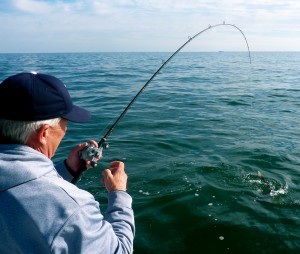 I recently discussed light tackle with some fishing buddies over a bottle of Tennessee’s finest. We all agreed that casting artificial lures on the Chesapeake Bay has the potential to catch as many big fish as any other method. I believe the chances for a trophy striper are better for those who know how to handle a light stick. Until a couple of years ago, most Mid-Atlantic fishermen would have laughed at a statement like that, but not anymore. Throughout 2010, light tackle casting held its own and often out-produced other methods of Chesapeake Bay fishing. It’s encouraging to walk into bait shops and tackle stores now and see Bass Kandy Delights, Bass Assassins, and top water plugs displayed prominently at the end of the aisles beside umbrella rigs and parachute lures. I’m very happy to promote light tackle fishing for one main reason – I don’t know a single light tackle fisherman who isn’t a conservationist. It is absolutely clear that anglers who cast artificial lures are hard-wired to protect the fish and to take care of the water they fish in. Read More!
I recently discussed light tackle with some fishing buddies over a bottle of Tennessee’s finest. We all agreed that casting artificial lures on the Chesapeake Bay has the potential to catch as many big fish as any other method. I believe the chances for a trophy striper are better for those who know how to handle a light stick. Until a couple of years ago, most Mid-Atlantic fishermen would have laughed at a statement like that, but not anymore. Throughout 2010, light tackle casting held its own and often out-produced other methods of Chesapeake Bay fishing. It’s encouraging to walk into bait shops and tackle stores now and see Bass Kandy Delights, Bass Assassins, and top water plugs displayed prominently at the end of the aisles beside umbrella rigs and parachute lures. I’m very happy to promote light tackle fishing for one main reason – I don’t know a single light tackle fisherman who isn’t a conservationist. It is absolutely clear that anglers who cast artificial lures are hard-wired to protect the fish and to take care of the water they fish in. Read More!
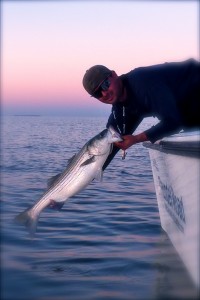 Since I’ve been reporting bigger migratory fish on my recent trips, I’ve been overwhelmed with questions about where the fish are. My apologies if I’ve yet to return a call or answer an email, but the absolute truth is – I don’t know. These big fish are moving around very quickly and they haven’t been at the same place twice. I think we sometimes put too much emphasis on locations, and not enough on patterns. Tell someone where to go to catch a fish and you may help them for a day, but teach them how to identify specific patterns of how fish behave, and you’ve helped them for a lifetime. Ask any good fisherman the secret to repeated success and he’ll tell you it’s the ability to distinguish specific feeding habits. I believe that you can drop a good fisherman into any body of water in the world and he’ll catch fish as long as you give him enough time to establish a prevailing pattern. It’s especially important on the Chesapeake where conditions change quickly and a rapid thirty degree temperature drop in October is not unusual. I think fishing conditions change faster and more often here than anywhere I’ve fished before. Fortunately, fish are usually creatures of habit and there are distinct patterns we can identify in the way they behave. Read More!
Since I’ve been reporting bigger migratory fish on my recent trips, I’ve been overwhelmed with questions about where the fish are. My apologies if I’ve yet to return a call or answer an email, but the absolute truth is – I don’t know. These big fish are moving around very quickly and they haven’t been at the same place twice. I think we sometimes put too much emphasis on locations, and not enough on patterns. Tell someone where to go to catch a fish and you may help them for a day, but teach them how to identify specific patterns of how fish behave, and you’ve helped them for a lifetime. Ask any good fisherman the secret to repeated success and he’ll tell you it’s the ability to distinguish specific feeding habits. I believe that you can drop a good fisherman into any body of water in the world and he’ll catch fish as long as you give him enough time to establish a prevailing pattern. It’s especially important on the Chesapeake where conditions change quickly and a rapid thirty degree temperature drop in October is not unusual. I think fishing conditions change faster and more often here than anywhere I’ve fished before. Fortunately, fish are usually creatures of habit and there are distinct patterns we can identify in the way they behave. Read More!
![DSC_0177[1]](http://www.chesapeakelighttackle.com/wp-content/uploads/2010/09/DSC_01771-300x242.jpg) Don’t tell me the moon is shining
Show me the glint of light on broken glass – Anton Chekhov
Don’t tell me the moon is shining
Show me the glint of light on broken glass – Anton Chekhov
The full moon that occurs closest to the autumn equinox (the first day of Fall) is called the Harvest Moon. It gets the nickname because there is bright moonlight from before sunset to almost sunrise so there is plenty of nighttime light for activities such as gathering crops. It’s also one of the best moons for fishing the Chesapeake Bay. I pay very close attention to the phases of the moon. Not only do they tell me a lot about water levels and the intensity of expected currents, they also provide information about fish behavior. Striped bass feed at night. While you aren’t likely to see younger Chesapeake stripers blitzing under the full moon, the big girls are usually on the prowl beneath bright night skies. I like to fish after dark during the spring and fall. By now you’ve likely read my recent reports about the great shallow-water action we’ve had this year. Nothing gets my blood boiling like nice fish blowing up on top-water plugs in less than a foot of water. For the past month or so shallow-water stripers have been extremely active in the late afternoon hours. The shore-side feeding frenzy usually begins around 5:00 PM and builds to a crescendo before turning off just after sunset. Things pick back up just before sunrise and continue until the day gets bright. This week, thanks to the full harvest moon, all bets are off. As you can see in the video, the shallow bite is wide open though both daylight and dark. Read More!
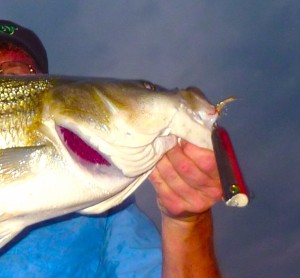 On a recent trip to my family farm in Eastern Tennessee I was rummaging though my dad’s old workshop and came across some lures he worked on. After dad passed in 1999, my brothers and I shared a lot of his fishing gear, but there was too much to take it all. During his busy lifetime that included fishing, managing bait shops and running boat docks, he collected a lot of stuff. For as long as I remember my father was a lure maker. Some of my earliest memories include opening the door to his shop and being blasted by the smothering fumes of burnt worm plastic. I still have scars from when I disobeyed, got too close to the melting pot and got splattered by hot lead. Sometimes I wonder how I’ve lived to be fifty years old considering all the chemicals I was exposed to as a child. (I also used to chew lead sinkers instead of bubble gum, but that’s another story.) Even though some of those lure making memories aren’t too pleasant, finding the old cedar blanks he started made me smile. Read More!
On a recent trip to my family farm in Eastern Tennessee I was rummaging though my dad’s old workshop and came across some lures he worked on. After dad passed in 1999, my brothers and I shared a lot of his fishing gear, but there was too much to take it all. During his busy lifetime that included fishing, managing bait shops and running boat docks, he collected a lot of stuff. For as long as I remember my father was a lure maker. Some of my earliest memories include opening the door to his shop and being blasted by the smothering fumes of burnt worm plastic. I still have scars from when I disobeyed, got too close to the melting pot and got splattered by hot lead. Sometimes I wonder how I’ve lived to be fifty years old considering all the chemicals I was exposed to as a child. (I also used to chew lead sinkers instead of bubble gum, but that’s another story.) Even though some of those lure making memories aren’t too pleasant, finding the old cedar blanks he started made me smile. Read More!
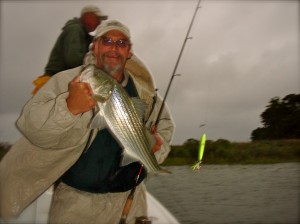 Fall is coming fast to the Chesapeake region bringing changing patterns in fish behavior. This is the time when resident Bay rockfish move shallow and start feeding heavily in order to put on winter weight. While there are still active fish in the open waters over the oyster bars and around the mid-Bay islands, the real fun is close in to the shore; so close in fact that you really don’t need a boat. A kayak or even waders are more appropriate this time of year, the only challenge being access to the best fishing spots. It’s tough to get most center console style fishing boats in tight enough to shore. Many light tackle anglers compromise by going with a bay style boat. That’s a good idea, but since I also fish the big water in the worst of the winter, I prefer a larger ride with a steeper deadrise. Due to the savvy design skills of Eastern Shore boat builder Bill Judge, I feel like I have the best of both worlds. Thunder Road, my 2010 Judge 27 CC only draws about 16 inches. I’ve put all 16 to use and then some over the past couple of weeks while working the grass beds of Talbot and Dorchester counties. Check out the video below and you’ll see what I mean. Read More!
Fall is coming fast to the Chesapeake region bringing changing patterns in fish behavior. This is the time when resident Bay rockfish move shallow and start feeding heavily in order to put on winter weight. While there are still active fish in the open waters over the oyster bars and around the mid-Bay islands, the real fun is close in to the shore; so close in fact that you really don’t need a boat. A kayak or even waders are more appropriate this time of year, the only challenge being access to the best fishing spots. It’s tough to get most center console style fishing boats in tight enough to shore. Many light tackle anglers compromise by going with a bay style boat. That’s a good idea, but since I also fish the big water in the worst of the winter, I prefer a larger ride with a steeper deadrise. Due to the savvy design skills of Eastern Shore boat builder Bill Judge, I feel like I have the best of both worlds. Thunder Road, my 2010 Judge 27 CC only draws about 16 inches. I’ve put all 16 to use and then some over the past couple of weeks while working the grass beds of Talbot and Dorchester counties. Check out the video below and you’ll see what I mean. Read More!


